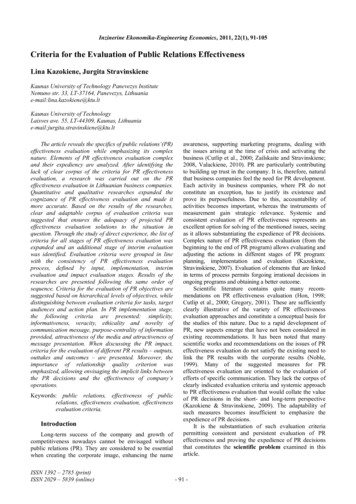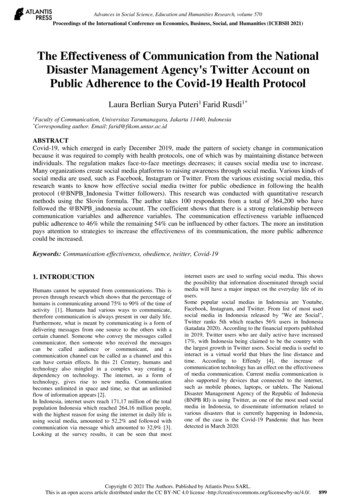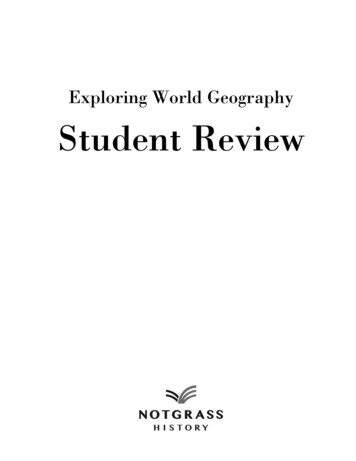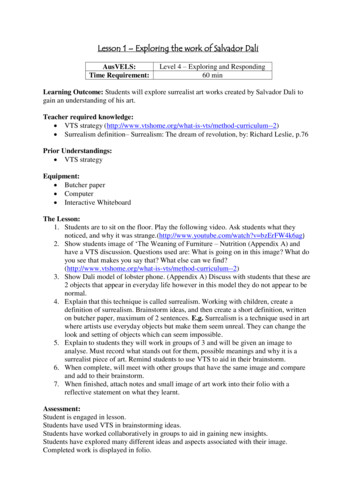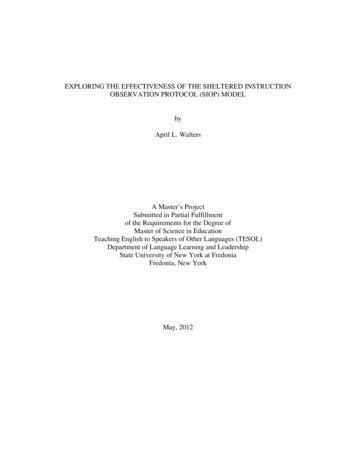
Transcription
EXPLORING THE EFFECTIVENESS OF THE SHELTERED INSTRUCTIONOBSERVATION PROTOCOL (SIOP) MODELbyApril L. WaltersA Master’s ProjectSubmitted in Partial Fulfillmentof the Requirements for the Degree ofMaster of Science in EducationTeaching English to Speakers of Other Languages (TESOL)Department of Language Learning and LeadershipState University of New York at FredoniaFredonia, New YorkMay, 2012
Running head: EFFECTIVENESS OF THE SIOP MODELAbstractFew empirical studies specifically address the effectiveness of the Sheltered InstructionObservation Protocol (SIOP) as a professional development tool, an instructional model, or atool for measuring sheltered instruction implementation. This study attempted to add to theliterature regarding the effectiveness of SIOP. Approximately 458 teachers from five schooldistricts in Western New York were surveyed electronically to inquire about the grades andsubjects they taught, years of teaching experience they had, type of training or professionaldevelopment they had, and presence of English language learners (ELLs) in their classrooms. Asubset of six teachers from four schools in three school districts were observed using the SIOPevaluation rubric and then interviewed. Survey, observation, and interview data were analyzed inattempt to answer the following question: Do teachers without SIOP training work as effectivelywith ELLs as do SIOP-trained teachers when defined and measured by the SIOP evaluationrubric? Data was analyzed and results indicated that some non-SIOP trained teachers had equalor higher total and mean observation scores than SIOP trained teachers. Results also question thevalidity and reliability of the SIOP evaluation rubric as an accurate measure of shelteredinstruction (SI). Major implications suggest that further research is needed to discern whether ornot SIOP is a valid instrument for measuring successful SI or if the model serves as an effectivemeans of professional development.ii
EFFECTIVENESS OF THE SIOP MODELTable of ContentsPageIntroduction . 1Problem . 2Purpose. 3Significance. 4Theoretical Framework . 4Working with English Language Learners . 4Just good teaching. . 8Cognitive academic language learning approach (CALLA). . 11Sheltered instruction. . 12The SIOP Model . 13Effectiveness of the SIOP Model . 16Student achievement and academic outcomes. 18Teacher training and professional development outcomes. 20Testing the Efficacy of SIOP . 24Method . 25Sample. 26Phase I. 26Phase II. . 27Participants . 28iii
EFFECTIVENESS OF THE SIOP MODELPhase I. 28Phase II. . 28Procedure . 29Phase I. 29Phase II. . 31Survey. . 32The SIOP evaluation rubric. . 34Semi-structured interviews. . 35Data Analysis . 36Results . 37Phase I . 37Surveys. . 37Phase II. 43Observations. . 43Interviews. . 50Training . 51Adapting instruction. . 53Just good teaching . 55Self-perceptions of effectiveness. . 56Discussion . 57iv
EFFECTIVENESS OF THE SIOP MODELFindings. 57Survey statistics. . 57Training . 58Self-perceptions and attitudes. . 59Scoring issues. . 61Just good teaching. . 62Limitations to the Study . 64Conclusions and Implications . 66References . 69Appendix A . 75Appendix B . 81Appendix C . 83Appendix D . 88Appendix E . 89Appendix F . 90Appendix J . 95Appendix K . 96v
EFFECTIVENESS OF THE SIOP MODELList of Tables and FiguresTablePageTable 1: Original Sample: Teachers, Students and Grade Span by School & District . .27Table 2: Participants by School, District, Pseudonym, Grades and Subjects Taught .29Table 3: Participants Surveyed by District and School . 30Table 4: Certification Areas of Respondents with ELLS in their Classrooms . .38Table 5: Subjects Taught of Respondents with ELLS in their Classrooms . .39Table 6: Grades Taught of Respondents with ELLS in their Classrooms .40Table 7: Supplemental Survey Data from Non-SIOP Trained Teachers .44Table 8: Supplemental Survey Data from SIOP Trained Teachers .44Table 9: Individual and Average Composite SIOP Scores for Teachers by Observation Date .46Table 10: Adaptations Made for ELLs as Reported by All Participants Interviewed .54Table 11: Attitudes and Beliefs about Teaching ELLs as Reported by All Participants .56FigurePageFigure 1: Number of years teaching for survey respondents with ELLs in their classroom .41Figure 2: Percent of Teachers with ELLs Willing to Participate in Phase II .42Figure 3: Comparison of all SIOP observation percentage scores for each teacher .47Figure 4: Comparison of Average Scores on Specific SIOP Features for All Teachers . 49vi
EFFECTIVENESS OF THE SIOP MODEL1IntroductionAs the number of English language learners (ELLs)1 continues to grow in the UnitedStates, school administrators and teachers strive to find the best practices for educating thisdiverse group of students (Batt, 2010; de Jong & Harper, 2005; Francis & Vaughn, 2009;Giouroukakis, Cohan, Nenchin, & Honigsfeld, 2011; Wright, 2010). There is increasingly morepressure from federal and state education policies, such as No Child Left Behind (NCLB), toimprove academic achievement among ELLs (Batt, 2008; Friend, Most, & McCrary, 2009;O’Neal, Ringler, & Lys, 2009). Whether or not ELLs find success in school depends uponseveral variables, some of which include the adequacy of teacher preparation (Francis &Vaughn, 2009; McIntyre, Kyle, Chen, Muñoz, & Beldon, 2010), the effectiveness of theinstructional model being used, and the level of teacher implementation of instructional practices(Echevarria, Vogt, & Short, 2004; Giouroukakis et al., 2011; McIntyre et al., 2010). While it hasbeen argued that effective teaching of ELLs is simply a matter of just good teaching (JGT) andcultural competence (de Jong & Harper, 2005; Harper & de Jong, 2004; Ladson-Billings, 1995;Ladson-Billings, 2009) some believe that courses in pedagogy have not provided teachers withthe tools they need to successfully educate ELLs (de Jong & Harper, 2005; Giouroukakis et al.,2011; Harper, de Jong, & Platt, 2008). For example, university courses in pedagogy may notaddress second language acquisition (SLA) or how language is used in specific content areas(Schleppegrell & O’Hallaron, 2011). Likewise, courses may be taught by faculty who have nobackground in teaching English to speakers of other languages (TESOL) (Giouroukakis et al.,2011). While research continues in this field, there is still much debate over how to improve1ELLs are non-native speakers of English in the process of attaining English proficiency. Theyare referred to as limited English proficient (LEP) students in the federal No Child Left BehindAct (NCLB) of 2001 (Wright, 2010).
EFFECTIVENESS OF THE SIOP MODEL2teacher preparation and by extension, the education of culturally and linguistically diverse(CALD)2 students in mainstream classes (Batt, 2010; de Jong & Harper, 2005; Faltis, Arias, &Ramírez-Marín, 2010; Friend, Most, & McCrary, 2009; Harper et al., 2008). This studyaddresses the efficacy of one model (called the SIOP model) that is implemented across the U.S.,by surveying teachers, observing and evaluating both SIOP- and non-SIOP trained teachers, andinterviewing teacher professionals.ProblemWhile some may feel that teaching ELLs is simply a matter of JGT (de Jong & Harper,2005; Ladson-Billings, 1995) others suggest that teachers need specialized training to teachELLs (Echevarria et al., 2004; Faltis et al., 2010; Giouroukakis et al., 2011; Schleppegrell &O’Hallaron, 2011). ELLs require teachers who are prepared to address their linguistic, cultural,and individual needs while navigating mainstream or ESL classrooms. The Sheltered InstructionObservation Protocol (SIOP) Model is one example of a model used for training people to teachELLs. According to its creators, the SIOP model is currently used in most of the 50 states and inhundreds of schools across the U.S. as well as in several other countries” (Echevarria, Vogt, &Short, 2008). It is widely touted as one of the best models for working with ELLs (Batt, 2010;Center for Applied Linguistics, 2012; Hansen-Thomas, 2008) and is therefore used by schooldistricts across the country to provide professional development for teachers working with ELLs.The SIOP model is research-based and implemented by schools throughout the U.S., andtherefore could be viewed as a permanent professional development solution for teachers with2CALD refers to a mixture of linguistic and ethnic minority students (Wright, 2010). Englishlanguage learners (ELLs) may be included in this group, but culturally and linguistically diversestudents are not always ELLs, as this term may refer to African American students, or ethnicallydiverse students whose English is proficient.
EFFECTIVENESS OF THE SIOP MODEL3ELLs in their classrooms. On the contrary, existing studies are too few in number to provideenough evidence to confirm the effectiveness of SIOP as a professional development tool or aninstructional model.PurposeThe purpose of this study was to investigate the effectiveness and reliability of the SIOPmodel in terms of teacher implementation of the identified indicators for “high-quality shelteredinstruction,” as defined by the SIOP evaluation rubric (Echevarria et al., 2004, p. 17). The studyalso looks at the effectiveness of the SIOP model in terms of its use as a tool to measure effectiveimplementation of sheltered instruction (SI). Overall, the goal of this study was to ascertainwhether or not teachers without SIOP training work as effectively with ELLs as SIOP-trainedteachers. Some researchers propose that sheltered instruction and SIOP features are JGT (de Jong& Harper, 2005; Harper & de Jong, 2004; Ladson-Billings, 1995; Ladson-Billings, 2009), whichsuggests that this type of specific training is not required in order for teachers to work effectivelywith ELLs. However, while few studies have specifically tested the effectiveness of SIOP, somestudies imply that SIOP training does contribute to teachers working effectively with ELLs (Batt,2010; Crawford, Schmeister, & Biggs, 2008; Echevarria, Short, & Powers, 2006; Echevarria,Vogt, et al., 2004; Friend et al., 2009; McIntyre et al., 2010; O’Neal et al., 2009). In accordancewith the findings of the aforementioned studies, the researcher hypothesized that teacherswithout SIOP training would not be found to work as effectively with ELLs when compared toSIOP-trained teachers. Based on this hypothesis, the researcher expected higher observationscores on the SIOP evaluation rubric from SIOP-trained teachers than non-SIOP-trainedteachers.
EFFECTIVENESS OF THE SIOP MODEL4SignificanceA variety of instructional models, and techniques based on second language acquisition(SLA) theories have been developed and implemented in the United States in attempt to addressthe academic and language needs of ELLs (Ladson-Billings, 2009; Lightbown & Spada, 2006;Wright, 2010). Likewise, various teacher preparation programs such as Teach for Diversity(TFD) (Ladson-Billings, 2001), Cognitive and Academic Language Learning Approach(CALLA) (Chamot & O’Mally, 1994), TESOL programs at universities (Giouroukakis et al.,2011), and SIOP (Echevarria et al., 2004) have been created to improve the implementation ofinstructional models designed for teaching ELLs and CALD students.Through their research, de Jong and Harper (2005) and Ladson-Billings (2009) found thatmany people believe that programs aimed at teaching ELLs, such as SIOP, are simply a matter ofJGT. Furthermore, Faltis et al. (2010) suggest there is a lack of research literature regarding thepreparation of teachers to work effectively with ELLs. Empirical studies regarding effectivenessof SIOP as a professional development tool is relatively scarce (Batt, 2010, Echevarria,Richards-Tutor, Chinn, & Ratleff, 2011; Echevarria et al., 2006; Echevarria, Short, & Powers,2008; Echevarria et al., 2004; Friend et al., 2009; Guarino, Echevarria, Short, Schick, Forbes, &Rueda, 2001; O'Neal, Ringler, & Lys, 2009; Vogt & Echevarria, 2008). This research study isperhaps one of the first to explore the effectiveness of the SIOP model through the comparison ofSIOP observation scores of SIOP-trained and non-SIOP-trained teachers.Theoretical FrameworkWorking with English Language LearnersSchools in the U.S. now face the ever-present challenge of providing effective instructionfor a growing population of CALD students, many of whom are ELLs (Batt, 2010; de Jong,
EFFECTIVENESS OF THE SIOP MODEL52005; Echevarria et al., 2004; Gibbons, 2003; Ladson-Billings, 2009). Some schools areimplementing bilingual education through dual immersion programs or transitional bilingualprograms to address the needs of ELLs (Baker, 2006). These schools often employ bilingualteachers. In dual immersion programs, teachers deliver content area instruction in bothlanguages. This is a particularly useful model in U.S. schools where there are large populationsof children who share the same non-English L1. For example, in San Francisco there is a largeChinese community (U.S. Census Bureau, 2010) and therefore many children might speakMandarin or Cantonese at home. In a dual immersion school of English and Cantonese, nativeEnglish-speaking children might be taught math concepts in Cantonese as well as English, andnative Cantonese-speaking children would also learn the content in both their L1 and L2.Conversely, many schools across the nation have not adopted bilingual education; therefore alarge number of ELL students attend monolingual English schools with monolingual Englishspeaking teachers (Baker, 2006). Taking a monolingual (English-only) approach to teachingchildren who do not speak English at home can be problematic, especially for young childrenwho have not yet fully developed their L1 (Baker, 2006; Crawford & Krashen, 2007; Fillmore,2000). Monolingual programs are sometimes aimed at teaching children English as fast aspossible, which can have a negative impact on L1 development and maintenance (Baker, 2006;Crawford & Krashen, 2007; Fillmore, 2000).English as a second language (ESL)3 pull-out/push-in models are common among someschools. With the ESL model, ELLs receive special instruction from an ESL teacher. The ESLteacher either pulls the ELLs out of the general education setting, or pushes into the mainstream3ESL instruction focuses on assisting ELLs in gaining English proficiency as measured by statestandards. In ESL instruction, ESL is the content area or subject being taught (Wright, 2010).
EFFECTIVENESS OF THE SIOP MODEL6classroom for a certain amount of time each day. While ESL classes are used with bilingualmodels as well, ESL services within a monolingual context look different than within thebilingual setting. The overall goal of ESL classes can differ depending on the approach used andthe program setting. For example, some ESL classes are geared toward mastery of grammarwhile others focus more on basic communication skills (Crawford & Krashen, 2007). An ESLprogram within a monolingual school generally means that the ELLs receive ESL services for aset amount of time (usually one or two hours) during the school day, and then they are immersedin the general education setting for the remainder of the day. This illustrates that ELLs inmonolingual schools are immersed in the mainstream setting, usually with monolingual teachers,for at least two thirds of the average school day. Some schools rely on mainstream teachers toprovide ELLs with some form of sheltered instruction (SI) in an inclusive, mainstreamclassroom. Yet these teachers are often expected to provide such instruction to ELLs without aspecific model or program to follow (Crawford et al., 2008). Lacking adequate training, teachersin these schools may find it difficult to work effectively with the ELLs4 in their classrooms(Crawford et al., 2008; de Jong, 2005; Friend et al., 2009).Teacher effectiveness relies on sufficient and successful training and professionaldevelopment in teacher preparation programs (Crawford et al., 2008; de Jong, 2005; Friend et al.,2009). Some teacher-education programs address preparation for working with ELLs by addingcourses on linguistic diversity or multicultural education to their existing curriculum (LadsonBillings, 2001). A number of universities offer teacher education programs for TESOL at theundergraduate and graduate levels for teacher candidates pursuing careers as ESL teachers.4For the purposes of this research, working effectively with ELLs and effective teaching will bedefined by the SIOP evaluation rubric.
EFFECTIVENESS OF THE SIOP MODEL7However, not all teachers (pre-service and in-service) receive training as specialized as what isprovided in, for example, the SIOP model, to work successfully with ELLs. In fact, many generaleducation teachers report feeling inadequately trained for working effectively with CALDstudents in their classrooms (Crawford et al., 2008; Friend et al., 2009; Giouroukakis et al., 2011;Ladson-Billings, 2009). In a study of 23 mainstream teachers with ELLs in their classrooms,Crawford et al. (2008) found that the strongest theme to emerge during pre-professionaldevelopment interviews was “teachers’ desire to learn more about effective instructionalpractices for ELLs” (p. 335). Similarly, in another study involving content-area teachers fromtwo middle schools in Kansas, Friend et al. (2009) some teachers said they hoped to learn moreeffective instructional strategies to use with ELLs and one teacher expressed frustration with thenotion of putting an ESL student in a classroom with a teacher who is not ESL trained. Likewise,in their report of a study which took place in a large suburban school district with a large ELLpopulation, Giouroukakis et al. (2011) reported that teachers felt the need for professionaldevelopment in order to better serve their ELL students. Clearly many content area andmainstream classroom teachers feel the need to learn more about the best practices for educatingELLs.According to de Jong and Harper (2005) the National Center for Education Statisticssurvey data from 2002, revealed that 42% of teachers reported having ELLs in their classrooms,yet only 12.5% had received more than eight hours of training geared toward educating ELLs.These ELL students represent the fastest growing subgroup enrolled in U.S. schools; they areoverrepresented in the subgroup of students struggling academically and of high school dropouts (Baker, 2006; Echevarria et al., 2011; Menken, 2010; Wright, 2010). One suggestedexplanation for large numbers of ELLs struggling academically and/or dropping out of school is
EFFECTIVENESS OF THE SIOP MODEL8that the assessments used to determine academic achievement are generally created formonolingual native English speakers (Wright, 2010). Due to the linguistic complexity of stateexams in core subject areas such as Mathematics and Science, these assessments become ameasure of students’ English proficiency as well as their content area knowledge (Menken,2010). This makes passing state assessments and graduating from high school on time especiallydifficult for newcomer ELLs of high school age. Learning strategies and practices used byschools have also been attributed to low academic performance of ELLs in the U.S. (Baker,2006; Nan & Zia, 2010). Baker (2006) suggests that academic achievement of ELLs can beattributed in part to the type of program models being used in schools. For instance, higheracademic achievement may be more noticeable in strong bilingual settings such as two wayimmersion programs, while weaker bilingual programs such as pull-out ESL, may lead to lowerachievement among ELLs (Baker, 2006). Nan and Zia (2010) suggest that closing theachievement gap among minority students is largely a matter of teachers creating a positive andsupportive learning environment. This further illustrates an uncertainty among researchers andeducators regarding which models should be used for teaching ELLs and what the best programsare for training mainstream educators of ELLs.Just good teaching. One issue surrounding best programs and practices for educatingELLs in the United States has been the debate of whether or not teaching these linguisticallydiverse students effectively is a matter of just good teaching (JGT) (de Jong, 2005, LadsonBillings, 1995). For all intents and purposes, JGT refers to best practices for all students. Thereare numerous teaching strategies and practices that could be considered good teaching or bestpractices. However, there are a few specific teaching strategies which have shown up in theexisting literature time and time again in the context of best practices for school teachers.
EFFECTIVENESS OF THE SIOP MODEL9Connecting students’ background knowledge and experiences to academic or content concepts isone example of a good teaching practice which is often noted in the literature (de Jong & Harper,2005; Klein, 2006; Ladson-Billings, 1995; Valdés, 1996). Utilizing students’ funds of knowledge(Baker, 2006; Valdés, 1996), the use of specific grouping configurations, and interactiveactivities are fundamental elements in student-centered instruction which is often seen as anotherbest practice for all students (Diller, 2007; Klein, 2006). Scaffolding, as seen in guided readingand writing activities, is another example of a widely used practiced that may be considered JGT(Diller, 2007; Oczkus, 2007). Many of the best practices mentioned in the literature citeVygotsky’s constructivist theory and zone of proximal development (ZPD) in which childrenplay an active role in making meaning from academic experiences which are mediated by moreexperienced peers, parents, and/or teachers (Baker, 2006; Lightbown & Spada, 2006). In their2005 article, De Jong and Harper list JGT practices that can be used with native English speakersand ELLs alike. Some of these include activating prior knowledge, using cooperative learninggroups, hands-on activities, graphic organizers, and process writing. While these may very wellconstitute JGT practices for all students, the question still remains as to whether or not effectiveteaching of ELLs must go beyond these best practices aimed at native English speaking children.Ladson-Billings (1995) argues that JGT is not the best explanation for the successfulteaching methods employed by some; rather successful teaching is a matter of embracingculturally relevant pedagogy (CRP). By Ladson-Billings’ definition, teachers practicing CRPmake academic success a priority for all of their students, help their students develop culturalcompetence, and ensure that their students develop sociopolitical consciousness. In CrossingOver to Canaan, Ladson-Billings (2001) describes the Teach for Diversity (TFD) Programwhich was designed to prepare teachers for working more effectively with students from diverse
EFFECTIVENESS OF THE SIOP MODEL10backgrounds. According to Ladson-Billings (2001), working effectively with diverse learnersinvolves explicitly linking the curriculum to students’ background experiences. Ladson-Billings(2001) also writes about a teacher who incorporates her students’ dialect, African AmericanVernacular, when teaching Standard English grammar. While diversity and m
State University of New York at Fredonia Fredonia, New York . & Honigsfeld, 2011; Wright, 2010). There is increasingly more pressure from federal and state education policies, such as No Child Left Behind (NCLB), to . Wright, 2010). Likewise, various teacher preparation programs such as Teach for Diversity (TFD) (Ladson-Billings, 2001 .






